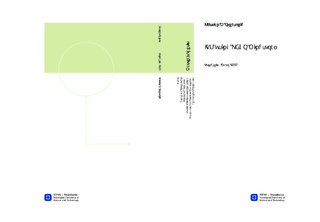| dc.description.abstract | Intelligent Transport Systems (ITS) is a general term for information-and
commuication systems aimed at making the transport sector more safe,
efficient and environmentally friendly. During the recent years, cars have
been equipped with numerous ITS applications such as parking assistant,
cruise control and even collision avoidance systems directly interfering
with the car to avoid an imminent collision. Car companies claim that
autonomous cars, i.e. cars capable of driving without human interference,
will be on the market by the end of the decade.
Private Rapid Transport (PRT) is an emerging public transportation
branch combining several different applications developed for ITS. The
main difference between PRT and more tradition public transport systems
is that the vehicles are operating on demand. When customers places an
order, the system will summon the closest vehicle, which will pick up the
customers and deliver them at the desired destination automatically. To
avoid interference with other vehicles and pedestrians, the vehicles will
run along specially built guideways usually separated by levitation. The
goal is to make PRT a realistic alternative to the private car by offering
close to the same privacy and flexibility. To offer the same flexibility as a
car, the system must provide sufficient departure and destination stations.
To achieve this, the guideways are intended to form a mesh network
scattered all over cities and their suburbs. However, no operational PRT
systems with more than five stations exist today.
Lego offers a wide range of products spanning from more or less
realistic models of trains and other vehicles to advanced programmable
robots. Mindstorms is Legos robotic theme, which was introduced in
1998. In this thesis, I have used EV3, which is the third generation of
Lego Mindstorms. EV3 features many different advanced sensors and
both powerful and accurate servo motors that can be connected to and
controlled by the EV3 intelligent brick. By installing the Lego Java
Operating System (LeJOS) on the intelligent brick, it is possible make
programs in Java and use all the libraries included in the Java 7 Standard
Edition. In addition, LeJOS makes the intelligent brick support WiFi
communication, leaving developers with their imagination as the biggest
restriction.
The different pieces are designed to be compatible with each other in
some way, regardless of age or theme. This means that a simple Lego toy
intended for children under the age of ten can be rebuilt and combined
with Lego Mindstorms to become a sophisticated robot. In this thesis I
have rebuilt three carriage Lego City trains into a single carriage PRT
vehicles, referred to as pods.
The purpose of this thesis is to determine whether or not it s possible
to simulate a real world PRT control system using Lego Mindstorms in
combination with Lego City trains. Because it seems like no one else
have ever attempted to do this, I have made a functional PRT system on
my own. The process is thoroughly described in this report and the work
is mainly divided into two objectives:
1. Design a pod that can drive to a given location with smooth and
realistic movements
2. Design a higher level control system that can command the pods to
move efficiently and safely between stations.
1. Although I used the physical pod design from my previous project at
NTNU, designing the pods control program to keep track of the pods
exact location was the most time consuming individual challenge in this
project. Early on, I decided to use the color sensor to count sleepers,
where each sleeper in the guideway represents a unique location. Because
I could not find any other projects using the Lego color sensor for a
similar purpose, I had to interpret the raw data from the color sensor and
process it into reliable location data on my own. When the color sensor
was able to detect each sleeper exactly once, it was relatively simple to
calculate the speed of the pod because I knew both the distance and time
between each sleeper. To make the pod stop smoothly at a given location,
I decided to use a quadratic function to calculate the required braking
distance based on the current speed. I also tested different approaches,
but without the same consistency as the quadratic function. In the end,
the result is a pod stopping at a given location with an accuracy of 10
cm. It accelerates and brakes smoothly. To communicate with a higher
level control system, I have chosen to use MQTT.
2. I have chosen to use a control system architecture consisting of
a central, multiple guideway controllers and one switch operator per
guideway controller.
The guideway controllers are responsible of one control area each.
There is one control area per switching intersection in the guideway and
pods can only enter a control area when ordered to by the guideway
controller in charge of that control area. Because the guideway controllers
are the only units that can allow a pod to move, it is responsible for the
safety, i.e. make sure the pods do not crash into each other. In addition,
the guideway controller sends switch commands to the switch operator
located in its area. When a pod approaches a switching intersection, the
guideway controller looks up the pods destination station in a table and
orders the switch operator to switch the tracks in the correct location to
route the pod the shortest path.
The switch operator receives switch orders from the guideway controller.
The switch operator is always aware of the tracks direction. If
the tracks are in the correct direction when it receives a switching order,
no further action is taken. If not, the tracks are switched in the correct
direction by rotating a motor connected to the switch handle.
The central was intended to assign orders to pods automatically and
constantly monitor the position of each pod to be able to detect congestion
and update the routing tables. Unfortunately, I did not have time to
make the central automatic. However, I have made a simple graphical
user interface where an operator manually can assign orders to pods. An
order can be set to repeat, which means that the pod will drive constantly
between the two given stations. By assigning multiple pods repeated
orders to move between different stations, a lot of interesting situations
occurs at both station tracks and merging intersections.
When I tested the control system by only using a simple computer
simulation, I was able to reveal some logical errors. When I had corrected
all these errors, I tested the control system in the lab. This instantly
exposed a lot of situations where the system failed, causing deadlocks
where one or more pods stopped at wrong locations because it wasn t
ordered to continue by the control system. After analyzing the results,
I was able to correct most of the errors. However, I did not have time
to make the system work perfectly. Nevertheless, most of the times, the
system now works as intended for many minutes before an error situation
occurs. By using the lab, I was able to expose errors I couldn t detect
using computer simulations. In addition, it was much easier to understand
the source of the errors from observing the pods behaviour. Based on this
experience, I have found that Lego Mindstorms is sufficiently advanced
and adaptable to simulate a simple PRT control system. | |

